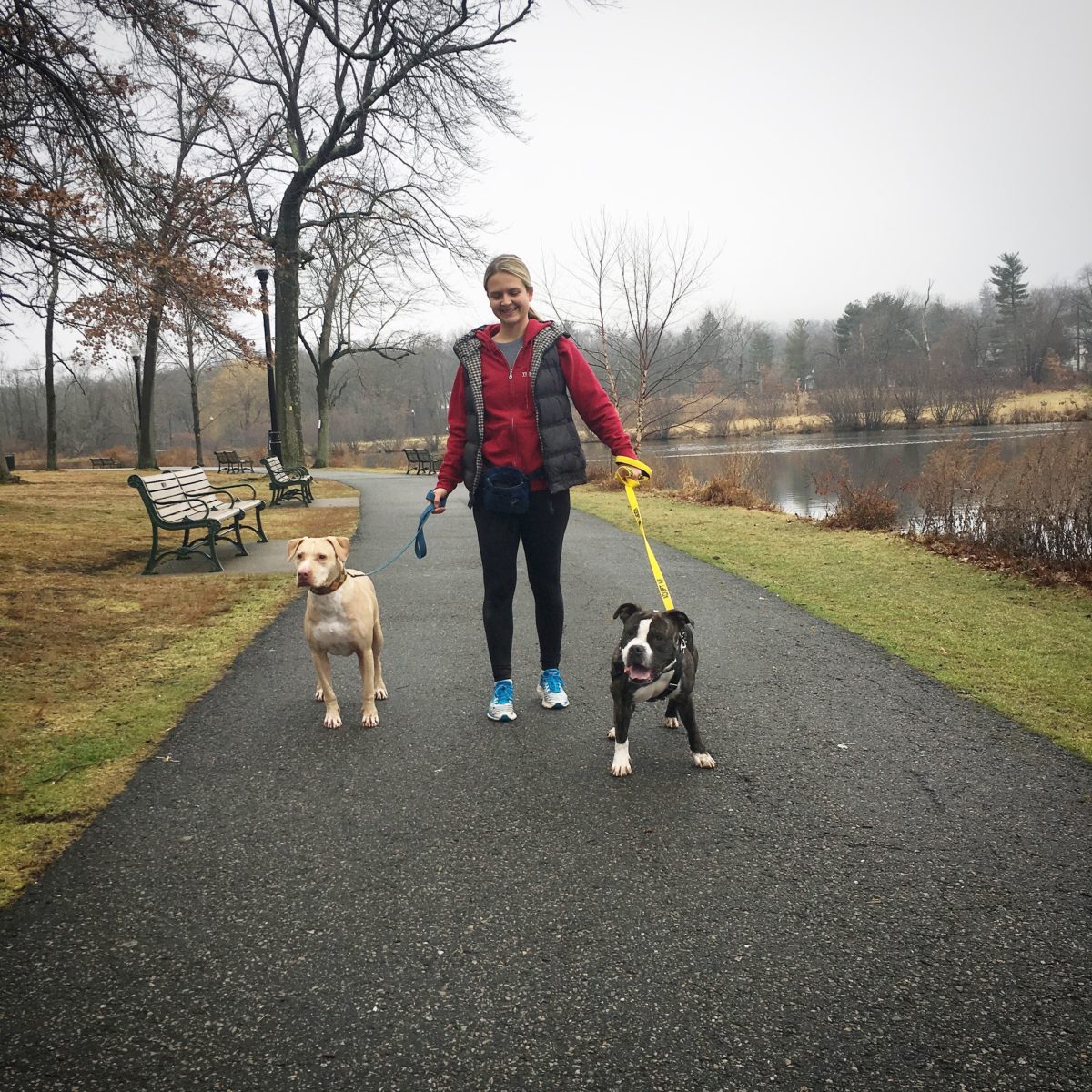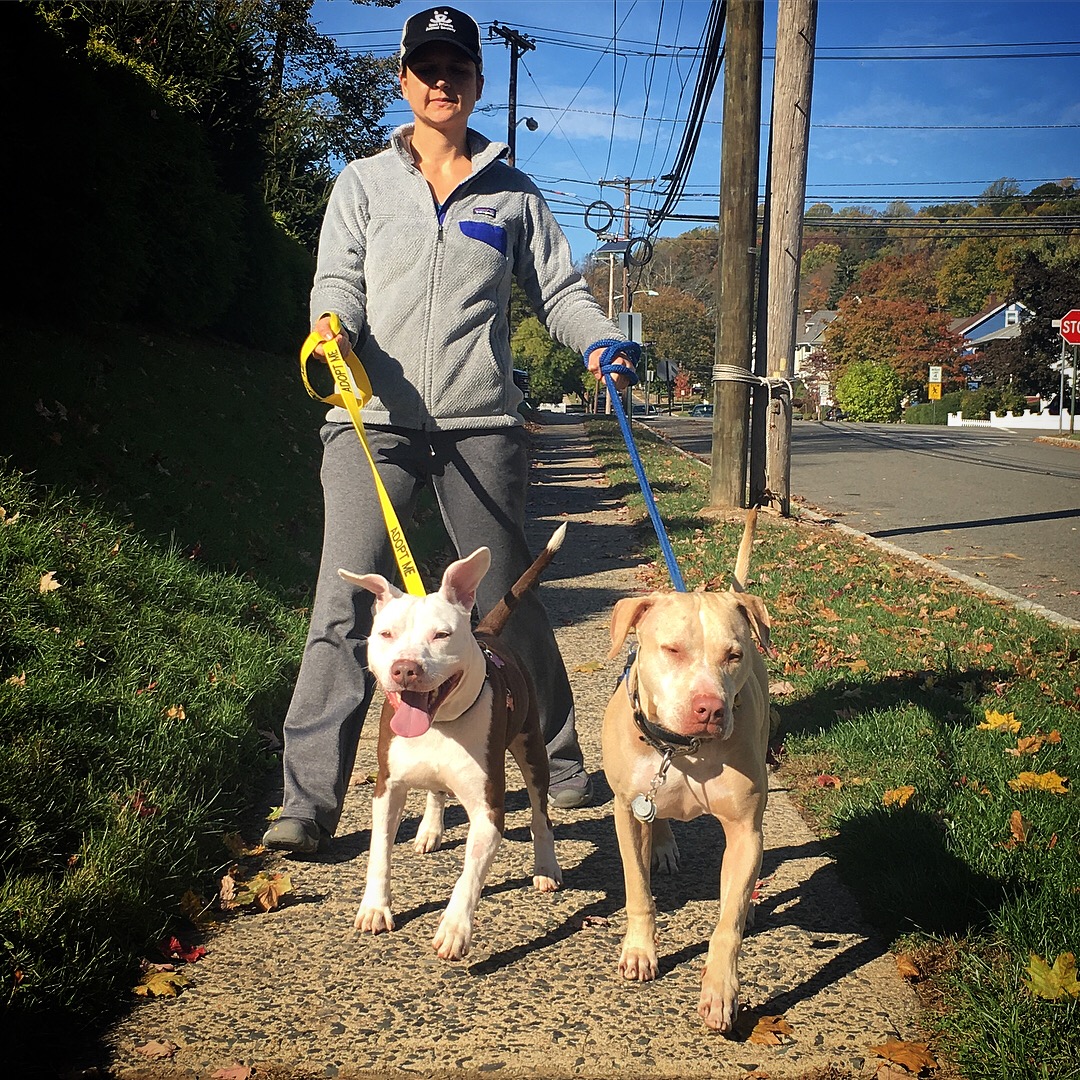
Walking is a large part of most dogs’ happiness. It gives them much-needed exercise, as well as mental stimulation as they get to smell, see, and experience new things. In fact, studies have shown that dog walking benefits us dog people and contributes to our happiness, as well. But what about walking two dogs at the same time? For some of us, this can be a challenge or even seem downright impossible. There is no question that walking one dog is much easier than two — as you may have noticed, our pack walking group only allows one dog per handler for that very reason. Hopefully these tips will help you get started on the path to walking while outnumbered.
Note: this advice is intended for dog people whose multiple dogs already know each other and get along well. If you are looking for advice about how to integrate a second dog, see this earlier post!
1. A strong foundation.
Don’t you hate it when you dive into an advice article, ready to learn how to solve your problems just by reading, only to learn that there’s significant prep work involved? Womp womp.
The number one piece of advice that I can give you when it comes to walking two dogs, is to make sure that your dogs have a strong foundation of loose leash walking skills.
My favorite resource for teaching loose leash walking is the late Sophia Yin’s four part tutorial: here, here, here, and here. Of course no online tutorial can ever take the place of hands-on training with a qualified trainer or behaviorist! Even if just one of the dogs you are walking has solid loose leash walking skills, you will be in much better shape than if both of them have only mediocre loose leash walking skills. (Many of Beau’s foster siblings have been natural pullers, but since he is an excellent loose leash walker, I can get by with walking two dogs consistently, even though their combined weight often exceeds mine!)
2. Three leashes and four hands.
A great way to first walk two dogs together is to recruit a friend (or patient significant other) to be the “secondary walker” of one of the dogs. I recommend choosing the dog with less reliable loose leash walking skills. Put two leashes on that dog (perhaps one on a collar and one on a harness, or two on a collar can work, too. Walk side by side, first with the second person holding their second leash more than you are holding yours, then eventually dropping the second leash and only grabbing it if needed for extra support. What you’re trying to do is have the dog start off thinking he or she has her own handler, but then settle in to walking side by side with the other dog, calmly, to the point where you can handle both dogs.
Seeing as you’ll be walking two (humans) across, if you can find a particularly wide sidewalk to work on this, that’s ideal.
3. Good gear.
I find it much easier to walk two dogs on identical leashes than ones that are different material, texture, length, or shape. Even better is if both dogs walk on the same harness (i.e. both on front clip or both on back clip, for example). This will give you a better grip on the leashes and reduce the odds of tangling up. But, if one dog is rock solid on certain walking equipment, it’s not worth sacrificing that for uniformity with the other dog!
4. Time and plan the route.
Especially on your first few walks where you are outnumbered by the dogs, you will want those walks to be as uneventful as possible. That might mean waking up very early to avoid school traffic, or perhaps walking a bit later at night with a headlamp on so it’s quiet and distractions are reduced. The same goes for known “triggers.” If you know that one of your dogs loses his you-know-what when you walk by a particular house that has a dog behind a fence, for example, you’ll want to plan a route that avoids that house!
5. Focus!
Multi-dog walks are the most successful if you can keep the dogs focused (or at least “checking in”) with you throughout. How do you maintain the dogs’ focus throughout the walk? Two main ways: (1) drain some of the energy before the walk (perhaps a quick session of tug or fetch before you head out on the walk) and (2) walk when they’re a little hungry, and treat liberally (I’m a big fan of giving the dogs only half of their breakfast, and having a pocket full of kibble mixed in with high value treats for rewards throughout the walk).
We have even had fosters that needed to run a couple of miles with me before they could settle in to a multi-dog walk with Beau. Know your dogs’ energy levels, and what drains that energy to get them in the right frame of mind to focus.
6. Short and sweet.
It’s going to take time to build up to long walks, so you should be prepared to continue your individual walks as you transition to multi-dog walks, particularly if walks are your dogs’ main source of exercise. Your first few multi-dog walks might just be up and down your block, and that’s okay!
7. End on a positive.
This piece of advice can go for just about any training you do with your dog. If the multi-dog walk is going really well, don’t push it. Loop back home while you’re still in your groove, rather than waiting until it falls apart. By ending on a positive your dogs will maintain better focus the next time, and you’ll feel optimistic, rather than defeated. It’s important for you to be in the right frame of mind, too, after all!
8. Practice, practice, practice.
Dogs are not going to learn to walk together with you if you don’t walk them together. You will have setbacks and might need to go back to the basics (two steps forward and one step back is still progress!) throughout the process, but stick with it!

